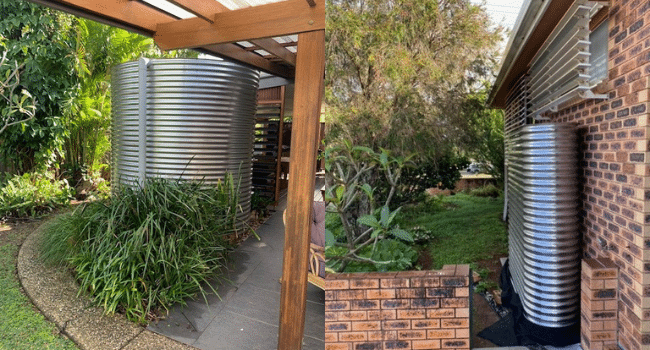Table of Contents
So you’ve heard that you can save hundreds of dollars a year and help save the planet by getting a water tank, but where to next? If you’re wondering what kind of water tank is right for you, read on!
There’s a few major decisions to consider:
- shape – is a slimline water tank or a round water tank right for you?
- size (capacity) – how much rainwater can your water tank harvest?
- Materials – poly (plastic), fibreglass, steel or concrete?
Without further ado, here’s our quick and easy guide to choosing a water tank.
Shape
When people think about water tanks, they stereotypically think about the enormous round tanks that are a common sight on farms. But water tanks are becoming an everyday sight in cities too; the difference is that many city dwellers will go for a slimline water tank, rather than a round water tank. The obvious reason for this is space-saving, because a slimline water tank has a streamlined rectangular shape, helping you make the most of the available space that you have. On the other hand, round water tanks are a bit cheaper, and will generally have a larger maximum capacity. For example, the slimline water tanks at Select Water Tanks (Brisbane) can hold up to 10,000L, while their round water tanks can hold up to 37,000L. So for a larger family or a small farm, round water tanks may be the best choice; for your average 4-person family with a smallish backyard, a slimline water tank will probably be the way to go.
Size (Capacity)
Water tanks come in vastly different sizes depending on your usage needs. To work out how much rainwater your water tank will need to hold, check your last few household water bills. You can safely assume that about half of your water consumption is used outdoors; so if you’re not planning to plumb your water tank in for indoors uses then you should be able to get by just fine with a water tank that holds half of your monthly water consumption as indicated on your bills. If you’re planning to use it for indoor uses (flushing toilets, doing laundry, etc) then you’ll likely want a tank that is equivalent to your monthly capacity.
Another factor is the rainfall in your area, and the size of your roof. there’s a simple formula for this: roughly 1mm of rain over 1 sqm of roof will equal 1 litre of harvestable rainwater.
Materials
This is the decision that people tend to struggle with the most, because there’s four major materials generally used for water tanks, and each have their own pros and cons.
In terms of initial cost, poly (plastic) water tanks involve the cheapest outlay, but they also degrade faster. Furthermore, they have little recycling value, so if the sustainability aspect of rainwater harvesting appeals to you, they’re not a great choice.
Fibreglass water tanks cost a little more but tend to have a longer lifespan because they’re more UV resistant. They also come with their own issues though, particularly the tendency to be an algae breeding ground. Also, they do have a tendency to crack, but the cracks are usually quite repairable. Lastly, they’re not recyclable as a general rule, so they’re not very planet-friendly.
Concrete water tanks have the longest lifespan, but they’re costly, so you won’t usually see them in residential or commercial settings.
Finally, the gold standard (or steel standard?) is steel water tanks, which are a bit most costly than fibreglass or poly, but last a whole lot longer (around 30 years), making them an investment that you and your family can enjoy for years to come.
We hope we’ve demystified the decisions surrounding water tanks! Watch out for more great articles like this on our blog.
Read More on KulFiy:
